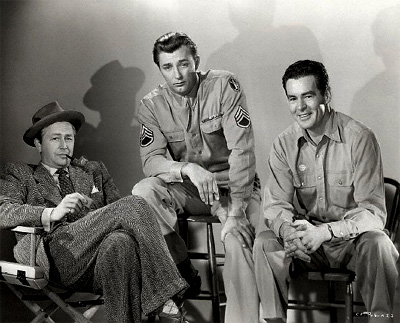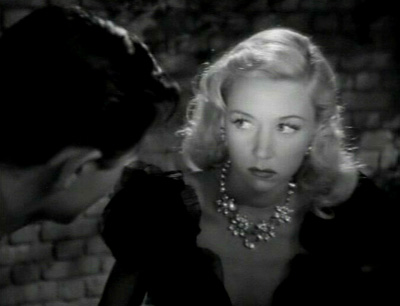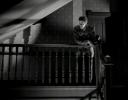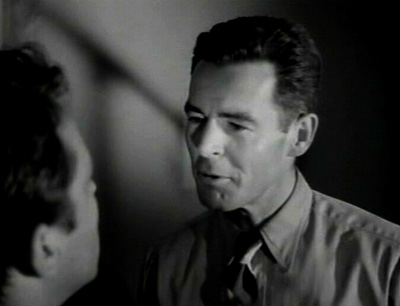
Like my previously discussed Arthur Kennedy obsession, my love for Robert Ryan is just as great. It’s odd to think that less than a year ago, I barely knew who he was. But seeing The Wild Bunch (1969) changed all that. Ryan captivated me as the reluctant bounty hunter, Deke Thorton. to the point where I lit up every time he appeared on screen. While I love everyone in that film, I found myself concerned about his character the most. He intrigued me like you wouldn’t believe (it doesn’t hurt that he’s also really handsome) and therefore, my newfound obsession with Robert Ryan was born.
 Besides his involvement in The Wild Bunch, Ryan is perhaps best known for his portrayal of the murderous anti-Semite, Montgomery, in Edward Dmytryk’s excellent 1947 film-noir, Crossfire (showing Saturday March 22nd at 8:15 am on TCM). Take one look at his filmography and you’ll see that more often than not, Ryan played psychotic heavies in about 80% of the films he was cast. This is probably due to Crossfire, in which he plays Montgomery as a man brimming with anger and hate, but in measured doses. He doesn’t, as they say, chew the scenery. Monty seems to be good-natured, until someone pushes the right buttons and his psychotic side comes forth. One of Ryan’s strengths was playing villains. No matter what the part, Ryan brought an intelligence to them. His villains were never over the top–instead, Ryan characterized them as thoughtful and quiet, never one dimensional cardboard cutouts. They thought before they spoke or lashed out. And while you hated them, you also felt a bit of sympathy towards them for being so evil. In movies such as Bad Day at Black Rock (1954) or House of Bamboo (1955), Ryan always stole every scene he was in. His mere presence was enough to capture your attention.
Besides his involvement in The Wild Bunch, Ryan is perhaps best known for his portrayal of the murderous anti-Semite, Montgomery, in Edward Dmytryk’s excellent 1947 film-noir, Crossfire (showing Saturday March 22nd at 8:15 am on TCM). Take one look at his filmography and you’ll see that more often than not, Ryan played psychotic heavies in about 80% of the films he was cast. This is probably due to Crossfire, in which he plays Montgomery as a man brimming with anger and hate, but in measured doses. He doesn’t, as they say, chew the scenery. Monty seems to be good-natured, until someone pushes the right buttons and his psychotic side comes forth. One of Ryan’s strengths was playing villains. No matter what the part, Ryan brought an intelligence to them. His villains were never over the top–instead, Ryan characterized them as thoughtful and quiet, never one dimensional cardboard cutouts. They thought before they spoke or lashed out. And while you hated them, you also felt a bit of sympathy towards them for being so evil. In movies such as Bad Day at Black Rock (1954) or House of Bamboo (1955), Ryan always stole every scene he was in. His mere presence was enough to capture your attention.
 The plot of Crossfire deals with the murder of Samuels (Sam Levene), who also happens to be Jewish. Investigating it is Captain Finlay (Robert Young), who suspects Mitchell (George Cooper) of committing the act, while another GI, Keely (Robert Mitchum), goes out on a limb to prove his friend’s innocence. Others getting tangled up in the mess are Mitchell’s wife, Mary (Jacqueline White), “nightclub hostess”, Ginny (the always sexy Gloria Grahame) and her dishonorably discharged husband (Paul Kelly). The missing piece of the puzzle is Montgomery, who not only killed Samuels at the beginning of the film, but also murders another GI, Floyd (Steve Brodie), the only witness at hand.
The plot of Crossfire deals with the murder of Samuels (Sam Levene), who also happens to be Jewish. Investigating it is Captain Finlay (Robert Young), who suspects Mitchell (George Cooper) of committing the act, while another GI, Keely (Robert Mitchum), goes out on a limb to prove his friend’s innocence. Others getting tangled up in the mess are Mitchell’s wife, Mary (Jacqueline White), “nightclub hostess”, Ginny (the always sexy Gloria Grahame) and her dishonorably discharged husband (Paul Kelly). The missing piece of the puzzle is Montgomery, who not only killed Samuels at the beginning of the film, but also murders another GI, Floyd (Steve Brodie), the only witness at hand.
Crossfire first emerged as a novel entitled, The Brick Foxhole. It was written in 1945 by Richard Brooks, who would go on in later years to direct such classics as Blackboard Jungle, Cat on a Hot Tin Roof and my personal favorite, Elmer Gantry. In the book, Conversations With the Great Moviemakers, Brooks, an ex-marine, explains that his novel was inspired by the group of men he was stationed with: “In my outfit, marines didn’t like black people, didn’t like Jews, didn’t like homosexuals, didn’t like Catholics. They didn’t like anybody except marines, Protestant marines, especially if they came from Texas or Atlanta.” In The Brick Foxhole, the character of Samuels was a homosexual and since the Hayes code disallowed “sex perversions”, he became Jewish. However, it turned out to be a timely change, especially with the horrors of the concentration camps beginning to surface.
 Like other actors of the era, Ryan enlisted in the Marine Corps in 1944, and while he never saw combat, he did become a drill instructor at Camp Pendleton in San Diego. It was during these years that Ryan read The Brick Foxhole. Afterwards, he got into contact with Brooks and told him that he would like to be considered for the role of Montgomery if it were ever made into a film. Brooks agreed. At that point, Ryan’s film career was rather short. He had been signed to Paramount for a brief period in 1940, but was dropped by the studio when they claimed that he was unsuitable for films. Now he was signed to RKO, where he appeared in second billed parts of a general nature. Perhaps Ryan saw Montgomery as a huge step forward–and it was. It not only garnered him rave reviews, but nabbed him the only Oscar nomination in his entire career. Ironically enough, Ryan would look back at the part with mixed feelings. While it did bring him to the public’s attention, it also lead to his being typecast as a villain. The public’s enthusiasm for Montgomery always mystified him, as he failed to see “the bone chilling evil I presumably projected.” Perhaps because in real life, Ryan was the complete opposite of his crazed characters. To say he was tolerant of other nationalities would be an understatement. Ryan despised racism, and was a supporter of many liberal political causes. He and his wife Jessica also founded a school, Oakwood, as they felt their children weren’t getting a proper education from the public and private systems. Whether through his acting or his social causes, Ryan wanted to make some kind of contribution to the world.
Like other actors of the era, Ryan enlisted in the Marine Corps in 1944, and while he never saw combat, he did become a drill instructor at Camp Pendleton in San Diego. It was during these years that Ryan read The Brick Foxhole. Afterwards, he got into contact with Brooks and told him that he would like to be considered for the role of Montgomery if it were ever made into a film. Brooks agreed. At that point, Ryan’s film career was rather short. He had been signed to Paramount for a brief period in 1940, but was dropped by the studio when they claimed that he was unsuitable for films. Now he was signed to RKO, where he appeared in second billed parts of a general nature. Perhaps Ryan saw Montgomery as a huge step forward–and it was. It not only garnered him rave reviews, but nabbed him the only Oscar nomination in his entire career. Ironically enough, Ryan would look back at the part with mixed feelings. While it did bring him to the public’s attention, it also lead to his being typecast as a villain. The public’s enthusiasm for Montgomery always mystified him, as he failed to see “the bone chilling evil I presumably projected.” Perhaps because in real life, Ryan was the complete opposite of his crazed characters. To say he was tolerant of other nationalities would be an understatement. Ryan despised racism, and was a supporter of many liberal political causes. He and his wife Jessica also founded a school, Oakwood, as they felt their children weren’t getting a proper education from the public and private systems. Whether through his acting or his social causes, Ryan wanted to make some kind of contribution to the world.
 Crossfire succeeds because of Ryan’s psychotic portrayal. When Keely (Mitchum) finds Mitchell (Cooper) and drags him into a darkened theater, Mitchell recalls a flashback from earlier in the night. Since he was drunk, his memory is hazy–yet, we see Montgomery and Samuels standing together, drinking. There’s a bit of an argument between the two and suddenly, Montgomery snarls, “No Jew is going to tell me how to two drink his stinking liquor!” It takes just the slightest word to set him off and expose the ugly hatred that lurks beneath. This is in contrast to the public persona of Montgomery that we see at the beginning of the film. When talking to Capt. Finlay, Monty has an almost wide-eyed and earnest innocence about him. But as the story progresses, more and more of Monty’s true nature is revealed. Right before the pivotal scene where Monty kills Floyd, he lashes out at him, yelling, “I don’t like Jews and I don’t like anyone who likes Jews!” For him, guilt by association is just as bad as being Jewish. But the one point that Crossfire lacks is the reason of why Monty hates the Jews so much. The most we ever get about his background is courtesy of Keely (Mitchum), who mentions that not much is known about him, except that Monty was a loner from all the way back. Did a Jewish person do something to him in the past? Or was he brought up to hate them? We’ll never know. Perhaps the book expounds on his character more, but for the film, it’s a pretty big flaw.
Crossfire succeeds because of Ryan’s psychotic portrayal. When Keely (Mitchum) finds Mitchell (Cooper) and drags him into a darkened theater, Mitchell recalls a flashback from earlier in the night. Since he was drunk, his memory is hazy–yet, we see Montgomery and Samuels standing together, drinking. There’s a bit of an argument between the two and suddenly, Montgomery snarls, “No Jew is going to tell me how to two drink his stinking liquor!” It takes just the slightest word to set him off and expose the ugly hatred that lurks beneath. This is in contrast to the public persona of Montgomery that we see at the beginning of the film. When talking to Capt. Finlay, Monty has an almost wide-eyed and earnest innocence about him. But as the story progresses, more and more of Monty’s true nature is revealed. Right before the pivotal scene where Monty kills Floyd, he lashes out at him, yelling, “I don’t like Jews and I don’t like anyone who likes Jews!” For him, guilt by association is just as bad as being Jewish. But the one point that Crossfire lacks is the reason of why Monty hates the Jews so much. The most we ever get about his background is courtesy of Keely (Mitchum), who mentions that not much is known about him, except that Monty was a loner from all the way back. Did a Jewish person do something to him in the past? Or was he brought up to hate them? We’ll never know. Perhaps the book expounds on his character more, but for the film, it’s a pretty big flaw.

Besides Ryan’s standout performance, also of note is Gloria Grahame. Like Ryan, she was dumped by her old studio (MGM) and picked up by RKO. As Ginny (because she’s from Virginia–a fact that will be proven false later in the film), she’s both tough and vulnerable. As the “nightclub hostess” who gets involved with Mitchell, she lets her guard down when he offers to dance with her in the garden of the club where she works, The Red Dragon. Grahame is not only perfect for the role, but she’s also the perfect noir femme fatale. She’s sexy and seductive, with a bit of innocence thrown in for good measure. I absolutely love her in every movie of hers I’ve seen and her role in Crossfire is no exception.
One of my favorite scenes in the whole film occurs when Capt. Finlay and Mitchell’s wife, Mary, arrive at Ginny’s apartment to question her. Taking Ginny out of her nightclub element brings out her defensive side, only softening to admit that she did like Mitchell because she felt sorry for him. Finlay’s questioning is further complicated by the sudden appearance of Ginny’s husband, who admits that he had a conversation with Mitchell earlier in the evening. While he’s a slight character and their relationship is only a subplot, I find Ginny and her husband (I don’t think he was given a first name in the film) to be fascinating, a perfect example of how pre-war marriages failed when the men came home. It’s a subject examined more thoroughly in 1946’s The Best Years of Our Lives (the failing marriage between Dana Andrews and Virginia Mayo), but here it’s sort of a postscript, albeit an interesting one. In one of the most disconcerting scenes, Ginny’s husband continues to talk about his failing marriage while Capt. Finlay and Mary walk away, leaving him alone. He admits that he still loves Ginny, although she despises him. But no one cares about his words or him. It’s as though the war has turned him into a lost soul.
to be fascinating, a perfect example of how pre-war marriages failed when the men came home. It’s a subject examined more thoroughly in 1946’s The Best Years of Our Lives (the failing marriage between Dana Andrews and Virginia Mayo), but here it’s sort of a postscript, albeit an interesting one. In one of the most disconcerting scenes, Ginny’s husband continues to talk about his failing marriage while Capt. Finlay and Mary walk away, leaving him alone. He admits that he still loves Ginny, although she despises him. But no one cares about his words or him. It’s as though the war has turned him into a lost soul.
 Which brings me to the other air of sadness that pervades Crossfire: the adjustment to normal civilian life that the returning soldiers faced. In the beginning of the film, when Keely tells Capt. Finlay about Mitchell, he explains that his current occupation is that of a printer and mentions that instead of the Purple Heart, he now works with purple ink. It’s a good example of how heroic men who once fought for our country are now reduced to menial jobs, since they received no formal job training afterwards. It really depresses the entire film. No matter what the “happy” ending is for Mitchell and his wife, their future is still going to be bleak. Not only is there his involvement with Ginny (as innocent as their relationship is, I would hate to find out my husband went to a “nightclub hostess”!) but he’s just a lowly painter as well. I’m sure his salary is hardly enough to support a wife on. It’s for these reasons that I find post-war movies to be interesting, since I think all the disillusionments really shaped the nation for the years ahead, finally culminating rebellious spirt of the 1960’s.
Which brings me to the other air of sadness that pervades Crossfire: the adjustment to normal civilian life that the returning soldiers faced. In the beginning of the film, when Keely tells Capt. Finlay about Mitchell, he explains that his current occupation is that of a printer and mentions that instead of the Purple Heart, he now works with purple ink. It’s a good example of how heroic men who once fought for our country are now reduced to menial jobs, since they received no formal job training afterwards. It really depresses the entire film. No matter what the “happy” ending is for Mitchell and his wife, their future is still going to be bleak. Not only is there his involvement with Ginny (as innocent as their relationship is, I would hate to find out my husband went to a “nightclub hostess”!) but he’s just a lowly painter as well. I’m sure his salary is hardly enough to support a wife on. It’s for these reasons that I find post-war movies to be interesting, since I think all the disillusionments really shaped the nation for the years ahead, finally culminating rebellious spirt of the 1960’s.

When it was released, Crossfire was a hit. Not only did it win Best Social Film at the Cannes Film Festival and the Edgar Allan Poe award for Best Picture, but it was nominated for five Academy Awards: Best Supporting Actor and Actress for Ryan and Grahame, Best Director for Dmytryk, Best Picture for Adrian Scott (producer) and Best Writing, Adapted Screenplay. Grahame, Dmytryk and the film itself lost out to the year’s other “social” picture, Gentleman’s Agreement (Celeste Holm won the Best Supporting Actress statue and Elia Kazan won for Best Director), while Ryan lost to Edmund Gwenn in Miracle of 34th Street. A snarling killer is no match for a lovable man masquerading as Santa Claus!
Sadly, the success of Crossfire brought negative attention to the people involved: Dmytryk, RKO producers Paul Jarrico and Scott, and Robert Ryan. The head of RKO at the time, Dore Schary, quickly dismissed any claims against Ryan by using his Marine Corps background to get him off the hook. The others weren’t so lucky–while Dmytryk rebounded after his inclusion on the Hollywood Ten list and Jarrico went on to make the only blacklisted film, Salt of the Earth, Scott found himself completely ruined.
Despite this, Crossfire is still a movie that manages to hold up today. While many people say that it’s a bit heavy-handed in it’s handling of racism, I tend to think of it as an excellent film noir murder mystery first and an anti-racism film second. As with many films, it’s the fantastic performances by the entire cast that make Crossfire worth watching. But it’s especially due to Robert Ryan and Gloria Grahame, who were so rightly nominated for Oscars. They’re what gives the film it’s punch, creating two characters who try to suppress their true feelings, only to wind up wearing them on their sleeves. I’m not sure if any other actors/actresses could be good in those roles–both Ryan and Grahame give their characters that extra something that elevates them above the rest. It’s especially uncomfortable to watch Ryan’s Montgomery, since he’s such a hateful person, but it’s countered by knowing that he was the complete opposite of that persona in real life. That’s the mark of a great actor–to take yourself out of your element and make it completely believable.
In a curious side note, that brings this article together in a really roundabout way, The Brick Foxhole was reprinted and reissued in 1952 as a cheap paperback. However, the actor that graced the cover was not Robert Ryan, but…Arthur Kennedy. How about that?
Link: Another vintage magazine advertisement for Crossfire (large, good quality)





